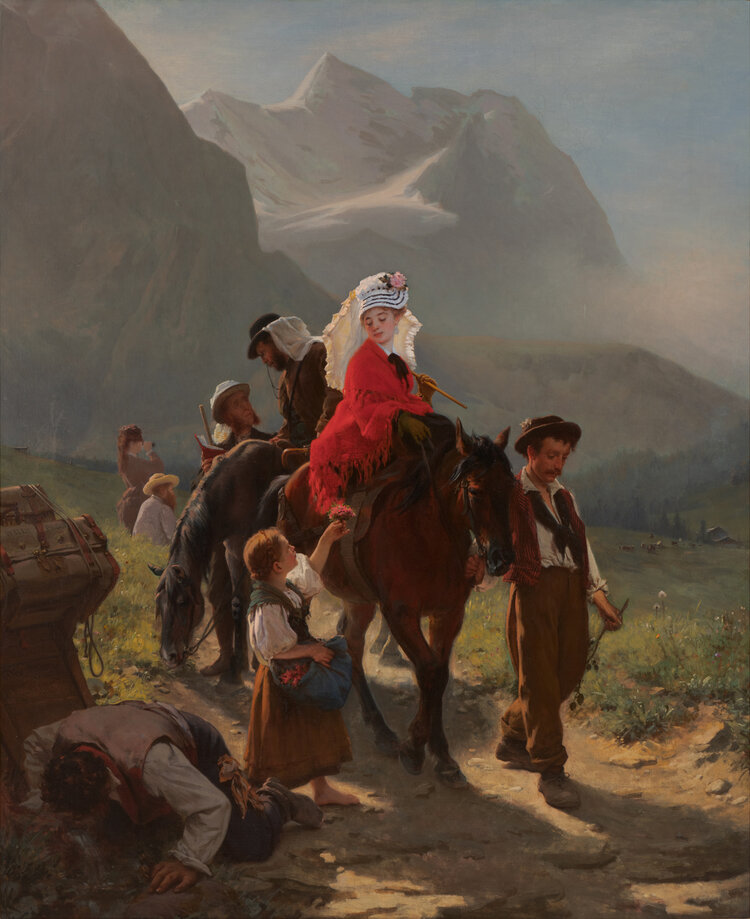Collection Connection is a series of personal responses by Museum staff and volunteers to works in the Frye Art Museum’s collection.

Attributed to Franz von Defregger (Austrian, 1835–1921). Visitors in the Tyrol, ca. 1875-79. Oil on canvas. 54 x 44 1/2 x 1 1/4 in. Founding Collection, Gift of Charles and Emma Frye, 1952.029. Photo Credit: Jueqian Fang.
A woman wearing a brilliant red shawl and carrying a sunlit parasol sits sidesaddle atop a horse in the midst of a majestic mountain meadow. It is a magnetic image that drew me across the gallery the first time I saw it. It is one of my favorite works of art from the Frye Art Museum Founding Collection: Visitors in the Tyrol (ca. 1875-79) attributed to the Austrian artist Franz von Defregger. As a Gallery Guide leading public tours of the Frye’s exhibitions, I have looked at this painting many times over the past nine years. The more I look, the more I see. I often wish I could share it with my mother. I’d love to ask her what she notices, what she thinks is going on in this painting.
Because of Covid-19, I haven’t been able to visit my mother in over a year. She is 99 years old, and she is my favorite art partner. There has been an empty hole in my life. Covid-19 has affected everyone in some way. As the pandemic has progressed it has become increasingly clear that some have been impacted more than others. Beyond the tragedy of death that this disease has brought, Covid-19 has widened the already existing inequities in health, work, technology, education, housing, transportation, and even access to the vaccine.
And all of this makes me think of Visitors in the Tyrol. But why?
Like the tourists to the Austrian Alps that this painting depicts, my first response to Visitors in the Tyrol was purely emotional. I was captivated by the natural atmospheric beauty of the alpine scenery. The advent of a mountain railway in the mid-nineteenth century allowed the beginning of tourism in the South Tyrol. An agricultural region, the Tyrol experienced a significant change as a number of grand hotels were built. Early tourists consisted primarily of the privileged aristocracy and the upper middle classes—those with money and leisure time. Crossing the Alps was a geographical challenge that required local guides and porters. The woman at the center of the painting with her bright red shawl dominates the scene. She is surrounded by seven other people. Who are these people and what is their relationship to her? Traveling companions? Guides? And what of the young barefoot girl who offers her a handpicked bouquet from her apron? It is the figure in the shadowy lower left corner of the painting who is of most interest to me. On close inspection, we see a man on hands and knees shoving his face in a small rivulet of water, trying to quench his thirst. To his side stands a pile of heavy luggage, presumably belonging to the woman in red and her companion(s). It is my guess that this man has been exhausted by the effort of carrying their cases on his back up the steep dirt trail. Each time I see this man face down in the dirt while the woman rides high above him, her body turned away in seeming oblivion to his suffering, I wonder about the glaring disparity between these wealthy sightseers and the local Austrians who served them. I wonder if the artist was lamenting the imbalance of status and power brought to rural life in the Tyrol by the burgeoning tourism industry. What do you think? If my mother were with me, I’d ask her. We always enjoy sleuthing meaning from the visual clues an artist gives us.
Unlike the woman in red who does not see the plight of those around her, I choose to see the inequities around me that have been magnified by this pandemic. I am well aware of my fortune and privilege at having everything I need to stay safe. Yes, I miss my mother, but we talk every week by phone, and I am thankful for that.
Marion Vokey
Gallery Guide